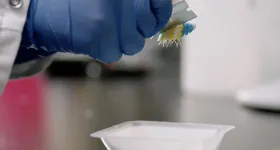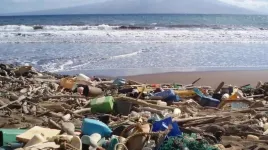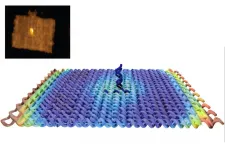(Press-News.org) Good news: The bacteria living on your toothbrush reflect your mouth - not your toilet.
After studying microbial communities living on bristles from used toothbrushes, Northwestern University researchers found those communities matched microbes commonly found inside the mouth and on skin. This was true no matter where the toothbrushes had been stored, including shielded behind a closed medicine cabinet door or out in the open on the edge of a sink.
The study's senior author, Erica Hartmann, was inspired to conduct the research after hearing concerns that flushing a toilet might generate a cloud of aerosol particles. She and her team affectionately called their study "Operation Pottymouth."
"I'm not saying that you can't get toilet aerosols on your toothbrush when you flush the toilet," Hartmann said. "But, based on what we saw in our study, the overwhelming majority of microbes on your toothbrush probably came from your mouth."
The study will be published Feb. 1 in the journal Microbiome.
Hartmann is an assistant professor of environmental engineering at Northwestern's McCormick School of Engineering. Ryan Blaustein, a former postdoctoral fellow in Hartmann's lab, was the paper's first author. Blaustein is now a postdoctoral fellow at the National Institutes of Health (NIH).
Collecting samples
To obtain toothbrushes for the study, Hartmann's team launched the Toothbrush Microbiome Project, which asked people to mail in their used toothbrushes along with corresponding metadata. Hartmann's team then extracted DNA from the bristles to examine the microbial communities found there. They compared these communities to those outlined by the Human Microbiome Project, an NIH initiative that identified and catalogued microbial flora from different areas of the human body.
"Many people contributed samples to the Human Microbiome Project, so we have a general idea of what the human microbiome looks like," Blaustein said. "We found that the microbes on toothbrushes have a lot in common with the mouth and skin and very little in common with the human gut."
"Your mouth and your gut are not separate islands," Hartmann added. "There are some microbes that we find both in the human gut and mouth, and those microbes are found on toothbrushes. But, again, those are probably coming from your mouth."
Clean mouth, clean toothbrush
During the research, Hartmann's team examined how many different types of microbes lived on the toothbrushes. They found people with better oral hygiene, who regularly flossed and used mouthwash, had toothbrushes with less diverse microbial communities.
"If you practice good oral hygiene, then your toothbrush also will be relatively clean," Hartmann said. "But it's a small difference. It's not like people who regularly floss, brush and use mouthwash have no microbes and those who don't have tons. There's just a bit less diversity on toothbrushes from people who do all those things."
The researchers also found that microbes from toothbrushes of people with better oral hygiene had slightly more antimicrobial-resistance genes. Hartmann said microbes with these genes did not match the human body and were likely from air or dust in the bathroom.
Hartmann stresses that there's no need to be alarmed by microbes living on your toothbrush. Unless your dentist recommends otherwise, people should not reach for antimicrobial toothpastes and toothbrushes.
"By using antimicrobials, you aren't just getting rid of microbes," Hartmann said. "You are pushing the surviving microbes toward antimicrobial resistance. In general, for most people, regular toothpaste is sufficient."
INFORMATION:
The study, "Toothbrush microbiomes feature a meeting ground for human oral and environmental microbiota," was supported by the Searle Leadership Fund, the NUSeq Core Facility Illumina Pilot Program and the National Institutes of Health (award number TL1R001423).
Greenhouse gas (GHG) emissions from agriculture, forestry and other land uses (AFOLU sector) cover the 24% of global emissions, representing the second hot spot in the contribution to climate change after the energy sector.
The main drivers are CO2 emissions from deforestation, methane (CH4) emissions produced by ruminant livestock and by anaerobic fermentation of organic matter, mainly from rice crops, and nitrous oxide (N2O) emissions from fertilizer use. Thus, the land sector plays a crucial role in the contribution to climate change.
A new study lead by the CMCC Foundation explores to which extent sustainable land management options applied at small-scale rural landscape level can be a valuable solution for increasing the mitigation potential of the land sector. ...
That is the question that Prof. Alan Deidun, resident academic within the Department of Geosciences of the Faculty of Science, along with a cohort of high-profile co-authors, posed within a study recently published in the Microplastics and Nanoplastics journal. Specifically, the study overviews a plethora of marine litter monitoring survey data available for different regions of the world ocean, as well as modelling data, in order to answer this compelling question.
The study, whose lead author is renowned litter researcher Dr Francois Galgani from IFREMER, concludes that, despite the well-known increase in the volume of plastics making their way ...
The impact of ozone on soybean production can be predicted more accurately thanks to improvements to a computer modelling system.
Surface ozone is a pollutant that affects plant growth by entering leaves and reducing the rate of photosynthesis, and rising ozone levels could severely limit production of crops including soy.
Being able to estimate this damage on soybean production using a "climate-vegetation model" is vital for predicting global and regional soy yields in the future.
This study uses results from a field experiment in the USA, which found that a normal ozone level of 10ppm/h (AOT40) could reduce soybean yield by 10%.
At extreme ozone levels - comparable to those observed on very polluted days in some parts of the world - soybean production fell to less than ...
Increases in life expectancy in the UK and elsewhere had slowed even before 2016 - and COVID-19 is expected to further eliminate any gains, Newcastle University studies show.
After 2011, over the post-financial crisis period the authors find that the UK performed poorly, in almost all measures, compared to the 28 countries of the European Union (EU28).
Life expectancy at birth, and age 65, in the UK were increasing rapidly in 2008 but slowed around 2011 and Germany, Portugal and France showed evidence of a similar slowing.
Furthermore, years of good health, called Healthy Life Years, at birth in the UK decreased, whereas it increased in most EU28 countries. The UK experienced a period ...
Using salt as a key ingredient, Chinese and British researchers have designed a new type of rechargeable battery that could accelerate the shift to greener, electric transport on our roads.
Many electric vehicles (EV) are powered by rechargeable lithium-ion batteries, but they can lose energy and power over time. Under certain conditions, such batteries can also overheat while working or charging, which can also degrade battery life and reduce miles per charge.
To solve these issues, the University of Nottingham is collaborating with six scientific ...
The year 2020 played host to an uncharacteristically large number of natural disasters. The year began with large wildfires in the Amazon rainforest and Australia. A series of wildfires broke out in the American states of California during summer and Oregon in September 2020. In particular, the Oregon wildfire intensified to an uncontrollable extent and was spread over a wide area by strong gusts of wind that carried it forward. These unseasonably strong winds may have been stoked by an unexpected source: typhoons on the other side of the Pacific Ocean.
In late August and early September, three storms--Bavi, Mayask, and Haishen--occurred just two weeks apart in the Korean peninsula, causing floods, mudslides, and several casualties. In a recently ...
T-cells are an important component of our immune system: with the receptors they carry on their surface, they can recognise highly specific antigens. Upon detection of an intruder, an immune response is triggered. It is still unclear exactly what happens when antigens are recognised: How many antigens are necessary to elicit an immune response, and does the response depend on their spatial arrangement?
These effects take place in the nanometer range - on the size scale of molecules, far below what can be seen with ordinary microscopes. To study all this, tiny tools are needed. Therefore, an unusual method was used at TU Wien: DNA molecules were folded in an ingenious way, similar to the paper folding ...
Students from lower socio-economic groups (SEG) are less likely to participate in sport or physical activity at university, research from Sheffield Hallam University has found.
The main barriers affecting participation were found to be down to cost of being part of a sports team, lack of time due to academic commitments, part-time working or their social life taking precedence and limited prior knowledge of and participation in sport before starting university.
Funded by British Universities and Colleges Sport and published in the peer-reviewed Sport, Education and Society journal, the study surveyed over 700 students from 20 universities and found those that had participated in sport and physical ...
A collaboration between the Pericàs group with Prof. Timothy Noël and Dr. Paola Riente at the Eindhoven University of Technology (TU/e, The Netherlands), has crystallised in a Nature Communications paper where they provide key insight into the chemical nature of the true photocatalyst involved in the Bi2O3-driven atom-transfer radical addition (ATRA) reaction.
Back in 2014, ICREA professors Miquel Pericàs and Emilio Palomares together with former postdoctoral researcher Dr. Riente published a paper on Angewandte Chemie International Edition pioneering the research on organic transformations in mild reactions conditions ...
The work of the research group under the guidance of Professor Leonid Martyushev (co-authors: Roman Bando and Evgenia Chervontseva) will help to predict the behavior of fluids in various environments.
"When oil wells are depleted, water is pumped there under pressure to force the residual oil to the surface. If the interface between water and oil were an even layer, then it would be safe to say that as a result of water injection we recover all the residual oil. But since the interface between the two liquids is a highly distorted section, oil, contrary to expectations, can still remain underground, while water comes out to the surface. This is where our calculations come in ...





